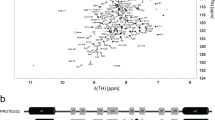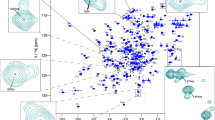Abstract
Yeast Fpr4p belongs to the FK506-binding protein (FKBP) class of peptidyl proline isomerases (PPIases), and has been implicated in regulating the cis–trans conversion of proline residues within histone tails. Here we report the 1H, 13C and 15N chemical shift assignments for the bacterially expressed C-terminal PPIase catalytic domain of Fpr4p. Prediction of secondary structure reveals similarity to domains from other members of the FKBP proline isomerases, including yeast Fpr1p and the prototypic PPIase region from human FKBP12.

Similar content being viewed by others
References
Arevalo-Rodriguez M, Wu X, Hanes SD, Heitman J (2004) Prolyl isomerases in yeast. Front Biosci 9:2420–2446
Delaglio F, Grzesiek S, Vuister GW, Zhu G, Pfeifer J, Bax A (1995) NMRPipe: a multidimensional spectral processing system based on UNIX pipes. J Biomol NMR 6:277–293
Kuzuhara T, Horikoshi M (2004) A nuclear FK506-binding protein is a histone chaperone regulating rDNA silencing. Nat Struct Mol Biol 11:275–283
Nelson CJ, Santos-Rosa H, Kouzarides T (2006) Proline isomerization of histone H3 regulates lysine methylation and gene expression. Cell 126:905–916
Schmid FX, Mayr LM, Mücke M, Schonbrunner ER (1993) Prolyl isomerases: role in protein folding. Adv Protein Chem 44:25–66
Senn H, Werner B, Messerle BA, Weber C, Traber R, Wüthrich K (1989) Stereospecific assignment of the methyl 1H NMR lines of valine and leucine in polypeptides by nonrandom 13C labelling. FEBS Lett 249:113–118
Shen Y, Delaglio F, Cornilescu G, Bax A (2009) TALOS+: a hybrid method for predicting protein backbone torsion angles from NMR chemical shifts. J Biomol NMR 44:213–223
Xiao H, Jackson V, Lei M (2006) The FK506-binding protein, Fpr4, is an acidic histone chaperone. FEBS Lett 580:4357–4364
Acknowledgments
We thank N. Sparks for assistance with cloning. This research was supported by funds from the Institut de Chimie des Substances Naturelles, the Aquitaine regional government, the Institut Européen de Chimie et Biologie, the French national equipment network for NMR spectroscopy (TGE RMN THC Fr3050) and the National Sciences and Engineering Research Council (NSERC 371680).
Author information
Authors and Affiliations
Corresponding author
Rights and permissions
About this article
Cite this article
Monneau, Y.R., Nelson, C.J. & Mackereth, C.D. Chemical shift assignments of the catalytic domain from the yeast proline isomerase Fpr4p. Biomol NMR Assign 6, 123–126 (2012). https://doi.org/10.1007/s12104-011-9338-x
Received:
Accepted:
Published:
Issue Date:
DOI: https://doi.org/10.1007/s12104-011-9338-x




